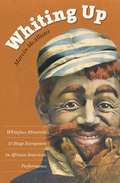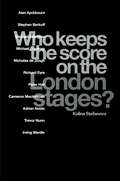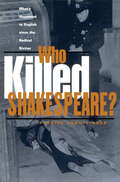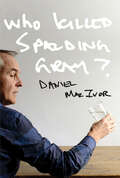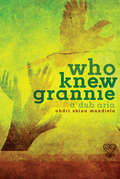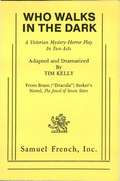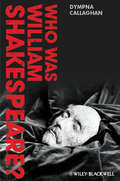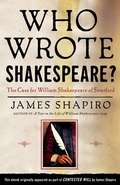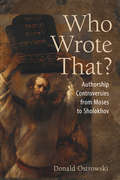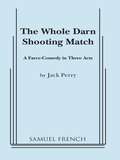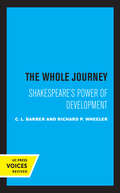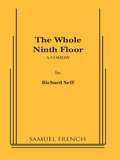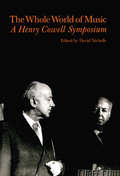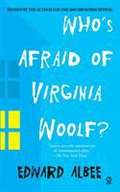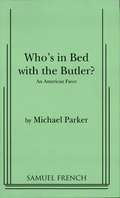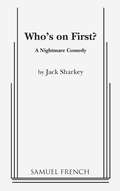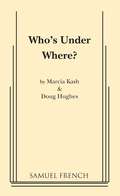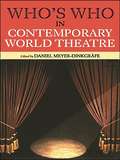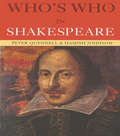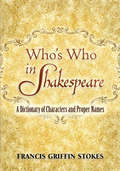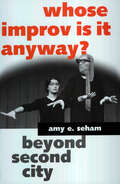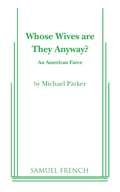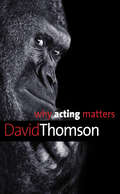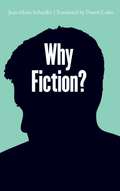- Table View
- List View
Whiting Up
by Marvin McallisterIn the early 1890s, black performer Bob Cole turned blackface minstrelsy on its head with his nationally recognized whiteface creation, a character he called Willie Wayside. Just over a century later, hiphop star Busta Rhymes performed a whiteface supercop in his hit music video "Dangerous." In this sweeping work, Marvin McAllister explores the enduring tradition of "whiting up," in which African American actors, comics, musicians, and even everyday people have studied and assumed white racial identities. Not to be confused with racial "passing" or derogatory notions of "acting white," whiting up is a deliberate performance strategy designed to challenge America's racial and political hierarchies by transferring supposed markers of whiteness to black bodies--creating unexpected intercultural alliances even as it sharply critiques racial stereotypes. Along with conventional theater, McAllister considers a variety of other live performance modes, including weekly promenading rituals, antebellum cakewalks, solo performance, and standup comedy. For over three centuries, whiting up as allowed African American artists to appropriate white cultural production, fashion new black identities through these "white" forms, and advance our collective ability to locate ourselves in others.
Who Keeps the Score on the London Stages?
by Kalina StefanovaHow does one become a theater critic in London? What do the theater critics think of their profession? How are they judged by those they critique? What do both critics and theatre-makers think of their mutual object of desire - the British Theatre?Who Keeps the Score on the London Stages? sets out to find the answers to these questions and many more in this long overdue publication on Britain's current theatre scene. Included are comprehensive interviews with more than fifty major London theatre critics and theater-makers, including Sir Alan Ayckbourn, Stephen Berkoff, Michael Billington, Martin Coveney, Nicholas de Jongh, Sir Richard Eyre, Sir Peter Hall, Sir Cameron Mackintosh, Adrian Noble, Sir Trevor Nunn and Irving Wardle. The author has gathered together a lively discussion about the contrmporary state of the British theatre, drawing a picture of its strengths, weaknesses and the problems it faces today. This volume serves as a long overdue guide to the Theatre critics' profession in Britain.
Who Killed Shakespeare: What's Happened to English Since the Radical Sixties
by Patrick BrantlingerFirst published in 2001. Routledge is an imprint of Taylor & Francis, an informa company.
Who Killed Spalding Gray?
by Daniel MacIvorSit down, Daniel’s going to tell you a story. On the weekend of January 10, 2004, American monologist Spalding Gray killed himself by jumping off the Staten Island Ferry in New York City. That same weekend, Daniel MacIvor was in California, visiting a psychic surgeon who offered to save his life by removing a spiritual entity that had attached to him. But what if Spalding’s death had something to do with Daniel’s entity? Linking these two true parallel stories is fiction derived from Gray’s obsessions and MacIvor’s inventions about a man named Howard who had forgotten how to live.
who knew grannie: a dub aria
by Ahdri Zhina MandielaIn this lyrical masterpiece, four cousins reunite in Jamaica to mourn the passing of their grandmother and to celebrate the times they shared together. There's vilma, an up-and-coming politician; kris, a celebrity chef; tyetye, who's incarcerated; and likklebit, who's immigrated to Canada. As the cousins reminisce about the woman who had such a strong role in rearing them, they uncover their troubles and begin to fulfill grannie's last task: to bring them back in tune with themselves.
Who Walks in the Dark: A Victorian Mystery-horror Play In Two Acts
by Tim KellyThriller / 5m, 6f, 1 optional m or f extra / This thrilling jewel is based on Stoker's classic suspense novel written after Dracula. By breaking into the tomb of an evil sorceress, archaeologist Sir Abel Trelawny has upset The Nameless One's plans for a return to the living. She comes to London's Karnak house (in which the play is set) and creates murderous havoc for Sir Abel, his two daughters and his bewildered staff. Comic relief is supplied by a bumbling sergeant who admires Sherlock Holmes. The occult mystery builds to a rousing climax, complete with dramatic twists that hold the audiences spellbound.
Who Was William Shakespeare
by Dympna CallaghanA new study of Shakespeare's life and times, which illuminates our understanding and appreciation of his works.Combines an accessible fully historicised treatment of both the life and the plays, suited to both undergraduate and popular audiencesLooks at 24 of the most significant plays and the sonnets through the lens of various aspects of Shakespeare's life and historical environmentAddresses four of the most significant issues that shaped Shakespeare's career: education, religion, social status, and theatreExamines theatre as an institution and the literary environment of early modern LondonExplains and dispatches conspiracy theories about authorship
Who Wrote Shakespeare?
by James ShapiroThis ebook is an excerpt from Contested Will by James Shapiro, and originally appeared as the last section titled "Shakespeare." In this chapter, Shapiro succintly and eloquently makes the case for why no one else but Shakespeare could have written Shakespeare's plays.
Who Wrote That?: Authorship Controversies from Moses to Sholokhov
by Donald OstrowskiWho Wrote That? examines nine authorship controversies, providing an introduction to particular disputes and teaching students how to assess historical documents, archival materials, and apocryphal stories, as well as internet sources and news. Donald Ostrowski does not argue in favor of one side over another but focuses on the principles of attribution used to make each case.While furthering the field of authorship studies, Who Wrote That? provides an essential resource for instructors at all levels in various subjects. It is ultimately about historical detective work. Using Moses, Analects, the Secret Gospel of Mark, Abelard and Heloise, the Compendium of Chronicles, Rashid al-Din, Shakespeare, Prince Andrei Kurbskii, James MacPherson, and Mikhail Sholokov, Ostrowski builds concrete examples that instructors can use to help students uncover the legitimacy of authorship and to spark the desire to turn over the hidden layers of history so necessary to the craft.
The Whole Darn Shooting Match: A Farce-Comedy in Three Acts
by Jack PerryZany exploits, hilarious antics and wild ideas follow fast and furiously throughout this comedy about the advertising world. It is set in the Creative Room where a flamboyant TV commercial writer, an alcoholic artist, a flippant girl Friday, and their beloved leader, the Creative Director, engage in a running feud with the new president of the company, an efficiency expert, the office boy and everyone else who dares to interfere with their off beat rules of office conduct.
The Whole Journey: Shakespeare's Power of Development
by C. L. Barber Richard P. WheelerThis title is part of UC Press's Voices Revived program, which commemorates University of California Press’s mission to seek out and cultivate the brightest minds and give them voice, reach, and impact. Drawing on a backlist dating to 1893, Voices Revived makes high-quality, peer-reviewed scholarship accessible once again using print-on-demand technology. This title was originally published in 1986.
The Whole Ninth Floor
by Richard SeffComedy / 6m, 5f / Interior / Across the street from the ‘mad men’ of Madison Avenue live the Ten Percenters of the National Talent Agency. It’s the same time, 1962, a secretary is still a toy, boys will still be boys, but the times they are a changin’. Audiences will love to hear what’s happening on The Whole Ninth Floor / “First impression is that it is a string of jokes tied together rather loosely. A moment’s concentration brings home however the basic fact that Seff weaves a story based on the young man’s intense and insistent desire to do the right thing. The laughs come fast, and they are plentiful.” - The Patterson Call
Whole World of Music: A Henry Cowell Symposium (Contemporary Music Studies)
by David NichollsFirst Published in 1998. Routledge is an imprint of Taylor & Francis, an informa company.
Who's Afraid of Virginia Woolf?
by Edward Albee"Twelve times a week," answered Uta Hagen, when asked how often she'd like to play Martha in Who's Afraid of Virginia Woolf? Like her, audiences and critics alike could not get enough of Edward Albee's masterful play. A dark comedy, it portrays husband and wife George and Martha in a searing night of dangerous fun and games. By the evening's end, a stunning, almost unbearable revelation provides a climax that has shocked audiences for years. With the play's razor-sharp dialogue and the stripping away of social pretense, Newsweek rightly foresaw Who's Afraid of Virginia Woolf? as "a brilliantly original work of art-an excoriating theatrical experience, surging with shocks of recognition and dramatic fire [that] will be igniting Broadway for some time to come."
Who's In Bed With Butler
by Michael ParkerFarce / 3m, 6f / Interior / A California billionaire has bequeathed all of his assets to his only daughter Constance - except the 22-million-dollar yacht he wanted Josephine to have, a 25 million-dollar art collection left to Rene and some priceless antique automobiles willed to Marjorie. Constance arrives at her father's mansion with her lawyer, determined to find out who these women are and to buy them off or contest the will. The butler seems to hold the key and she learns from him that the three sultry ladies were her father's lovers. She also discovers that the yacht, the art and the cars have vanished, all having been sold to The Bimbo Corporation. Could the butler be behind the shenanigans - and is he carrying on with all of the ladies in question? Does the elderly, deaf housekeeper really have a pet rat? Can the bumbling detective hired by Constance really be so inept, linguistically as well as professionally? And why has the butler hired an actress to play his wife? Hilarity erupts long before the audience realizes that the temptresses are all being played by the same actress! This is a madcap addition to the author's string of inventive American farces.
Who's on First?
by Jack SharkeyJack Sharkey. Full Length, Comedy. . Characters: 2 male, 2 female . Interior Set. Take a husband, wife, lover and friend, add a strange lamp, a gun and a rubber chicken plus a party that begins at 8 p.m., then again at 8 p.m. and then again at 8 p.m. and you have this nightmare comedy." Four people find themselves reliving one horrible hour over and over as themselves, as Japanese, as British aristocrats, as gangsters, and almost anything else you can think of. Camille is giving the party. Don shows up in a jealous funk about his wife, Alice, whom he suspects of seeing another man. When Alice and Ben have arrived, it turns out their relationship is innocent. But by the time Don realizes this he has already shot Ben, Alice and even Camille. Camille wishes that things might have turned out differently and that is what happens. All concerned find themselves back at the party's beginning again and again doomed to live that same hour over and over again until they get it right. Is it all an accident? Or is their dilemma part of someone's fiendish plan? A labyrinth of hilarity exits to a shocker of an ending.
Who's Orp's Girlfriend?
by Suzy KlineOrp's life becomes very complicated when he realizes that he likes two girls at the same time.
Who's Under Where?
by Doug Hughes Marcia KashMarcia Kash and Doug Hughes . Farce. Characters: 5 male, 2 female. Interior Set. Jane and Sybil are on the verge of the deal of their lives. They have rented a hotel suite for a very private showing of their "Passion Fashion Wear" lingerie. Only famous Italian designer Bruno Fruferelli is to attend. The models are booked, the champagne is on ice and the sexy samples are on display. They have anticipated every contingency, expect the arrival of their jealous husbands who have jumped to the wrong conclusions. Combine suspicious spouses, stolen underwear and mistaken identities with five million dollars, a scantily clad model and a lecherous security guard and you have the recipe for this giddy farce in the classic tradition. . "Audience members were actually left hiccuping, gasping for breath and wiping their eyes by the antics on stage." - The Muskoka Advance . "Side splitting comedy." - The Muskokan . "Hilarious." -Packet and Times
Who's Who in Contemporary World Theatre (Who's Who)
by Daniel Meyer-DinkgräfeWho's Who in Contemporary World Theatre is a lively and accessible biographical guide to the key figures in contemporary drama. All who enjoy the theatre will find their pleasure enhanced and their knowledge extended by this fascinating work of reference. Its distinctive blend of information, analysis and anecdote makes for entertaining and enlightening reading. Hugely influential innovators, household names, and a whole host of less familiar, international figures - all have their lives and careers illuminated by the clear and succinct entries. All professions associated with the theatre are represented here - actors and directors, playwrights and designers. By virtue of the broad range of its coverage, Who's Who in Contemporary World Theatre offers a unique insight into the rich diversity of international drama today.
Who's Who in Shakespeare (Who's Who)
by Hamish Johnson Peter QuennellWho's Who in Shakespeare presents a complete and handy guide to the men and women who throng Shakespeare's plays. It provides:* detailed biographical information on each leading figure* analyses of the role and significance of each minor figure* a reliable guide to the huge Shakespearian canon for student and teacher* quotations from famous critics* useful information on some of Shakespeare's sources.From Antonio to Yorick, Macbeth to Mercutio, this book embraces the breadth and depth of the world's most important playwright.
Who's Who in Shakespeare: A Dictionary of Characters and Proper Names (Dover Books On Literature And Drama Ser.)
by Francis Griffin StokesAlthough many of Shakespeare's allusions would have been familiar to the theater-goers of his day, we've come a long way from the language of the Globe Theater. This indispensable dictionary helps modern readers and audiences find their way back to the Elizabethan stage. With more than 3,000 entries, it encompasses all of the plays as well as the poems and sonnets. In addition to the historical, mythical, and fictitious characters themselves, the coverage extends to their references to other people, places, literature, and legends.Who's Who in Shakespeare offers an alphabetical guide to these names. It provides a specific identity and context for each, with quotations from the works in which they appear, from the sources which Shakespeare may himself have used, and from the writings of his contemporaries. The author has also contributed his own comments on the accuracy of some of the historical and geographical references, and on the links between the playwright's life and his choices of names.Entries for major characters feature brief analyses of their roles, arranged scene by scene. The plays appear under their individual titles, with details of their original publication and probable date of composition. A useful appendix contains family trees of the important ruling and noble houses at the time of the Wars of the Roses, plus a catalog of works included in the First Folio.
Whose Improv Is It Anyway?: Beyond Second City (Studies in Popular Culture Series)
by Amy E. SehamOn both sides of the stage improv-comedy's popularity has increased exponentially throughout the 1980s and '90s and into the new millennium. Presto! An original song is created out of thin air. With nothing but a suggestion from the audience, daring young improvisers working without a net or a script create hilarious characters, sketches, and songs. Thrilled by the danger, the immediacy, and the virtuosity of improv-comedy, spectators laugh and cheer. American improv-comedy burst onto the scene in the 1950s with Chicago's the Compass Players (best known for the brilliant comedy duo Mike Nichols and Elaine May) and the Second City, which launched the careers of many popular comedians, including Gilda Radner, John Belushi, and Mike Myers. Chicago continues to be a mecca for young performers who travel from faraway places to study improv. At the same time, the techniques of Chicago improv have infiltrated classrooms, workshops, rehearsals, and comedy clubs across North and South America, Europe, Australia, and Japan. Improv's influence is increasingly evident in contemporary films and in interactive entertainment on the internet. Drawing on the experiences of working improvisers, Whose Improv Is It Anyway? provides a never-before-published account of developments beyond Second City's mainstream approach to the genre. This fascinating history chronicles the origins of "the Harold," a sophisticated new "long-form" style of improv developed in the '80s at ImprovOlympic and details the importance and pitfalls of ComedySports. Here also is a backstage glimpse at the Annoyance Theatre, best known on the national scene for its production of The Real Live Brady Bunch. Readers will get the scoop on the recent work of players who, feeling excluded by early improv's "white guys in ties," created such independent groups as the Free Associates and the African American troupe Oui Be Negroes. There is far more to the art of improv than may be suggested by the sketches on Saturday Night Live or the games on Whose Line Is It Anyway? This history, an insider's look at the evolution of improv-comedy in Chicago, reveals the struggles, the laughter, and the ideals of mutual support, freedom, and openness that have inspired many performers. It explores the power games, the gender inequities, and the racial tensions that can emerge in improvised performance, and it shares the techniques and strategies veteran players use to combat these problems. Improv art is revealed to be an art of compromise, a fragile negotiation between the poles of process and product. The result, as shown here, can be exciting, shimmering, magical, and not exclusively the property of any troupe or actor.
Whose Wives Are They Anyway?
by Michael ParkerComedy / 3m, 5f / The Ashley Maureen Cosmetics Company has been sold and two of its vice presidents, David McGrachen and John Baker, have planned a weekend off before the new C.E.O. arrives on Monday. With their wives safely off on a shopping spree in New York City, they check into The Oakfield Golf and Country Club intending to "golf their brains out." They unexpectedly encounter their new boss, Ms. Hutchison, and she insists on meeting the wives, commenting blithely "no one who went golfing for a weekend without his wife would ever work for me." So ... David and John have to produce wives. John persuades Tina, the hotel's sexy receptionist, to play the role of his wife, but the only one who can pretend to be David's wife is John. Inevitably everything goes wrong as John moves in and out of bedrooms, changing from male to female at a frantic pace. Hilarious chaos ensues when the hotel phone system goes on the blink, Tina has too much champagne and can't keep her clothes on, and, yes, the real wives arrive!
Why Acting Matters
by David ThomsonDoes acting matter? David Thomson, one of our most respected and insightful writers on movies and theater, answers this question with intelligence and wit. In this fresh and thought-provoking essay, Thomson tackles this most elusive of subjects, examining the allure of the performing arts for both the artist and the audience member while addressing the paradoxes inherent in acting itself. He reflects on the casting process, on stage versus film acting, and on the cult of celebrity. The art and considerable craft of such gifted artists as Meryl Streep, Laurence Olivier, Vivien Leigh, Marlon Brando, Daniel Day-Lewis, and others are scrupulously appraised here, as are notions of "good" and "bad" acting. Thomson's exploration is at once a meditation on and a celebration of a unique and much beloved, often misunderstood, and occasionally derided art form. He argues that acting not only "matters" but is essential and inescapable, as well as dangerous, chronic, transformative, and exhilarating, be it on the theatrical stage, on the movie screen, or as part of our everyday lives.
Why Fiction? (Stages)
by Jean-Marie SchaefferOne of the most important works of narrative theory to come out of France in recent years―Jean-Marie Schaeffer understands fiction not as a literary genre but, in contrast to all other literary theorists, as a genre of life. The result is arguably the first systematic refutation of Plato’s polemic against fiction and a persuasive argument for regarding fiction as having a cognitive function. <P><P> For Schaeffer fiction includes not only narrative fiction but also children’s games, videos, film, drama, certain kinds of painting, opera―in short, all the intentional structures arising from shared imaginative reality. Because video games and cyber-technologies are the new sites of entry for many children into such an imagined universe, studying these cyber-fictions has become integral to our understanding of fiction. Through these avenues, Schaeffer also explores the foundations of mimeticism in order to explain the important effect fiction has on human beings. His work thus establishes fiction as a universal aspect of human culture and offers a profound and resounding answer to the question: Why fiction?
